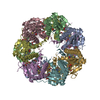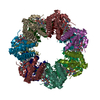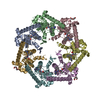+ Open data
Open data
- Basic information
Basic information
| Entry | Database: PDB / ID: 6vam | |||||||||
|---|---|---|---|---|---|---|---|---|---|---|
| Title | Cryo-EM structure of octameric chicken CALHM1 | |||||||||
 Components Components | Green fluorescent protein,CALHM1 chimera | |||||||||
 Keywords Keywords | MEMBRANE PROTEIN / taste / assembly / calcium | |||||||||
| Function / homology |  Function and homology information Function and homology informationvoltage-gated monoatomic ion channel activity / calcium-activated cation channel activity / monoatomic cation channel activity / bioluminescence / generation of precursor metabolites and energy / plasma membrane Similarity search - Function | |||||||||
| Biological species |   | |||||||||
| Method | ELECTRON MICROSCOPY / single particle reconstruction / cryo EM / Resolution: 3.63 Å | |||||||||
 Authors Authors | Syrjanen, J.L. / Chou, T.H. / Furukawa, H. | |||||||||
| Funding support |  United States, 2items United States, 2items
| |||||||||
 Citation Citation |  Journal: Nat Struct Mol Biol / Year: 2020 Journal: Nat Struct Mol Biol / Year: 2020Title: Structure and assembly of calcium homeostasis modulator proteins. Authors: Johanna L Syrjanen / Kevin Michalski / Tsung-Han Chou / Timothy Grant / Shanlin Rao / Noriko Simorowski / Stephen J Tucker / Nikolaus Grigorieff / Hiro Furukawa /   Abstract: The biological membranes of many cell types contain large-pore channels through which a wide variety of ions and metabolites permeate. Examples include connexin, innexin and pannexin, which form gap ...The biological membranes of many cell types contain large-pore channels through which a wide variety of ions and metabolites permeate. Examples include connexin, innexin and pannexin, which form gap junctions and/or bona fide cell surface channels. The most recently identified large-pore channels are the calcium homeostasis modulators (CALHMs), through which ions and ATP permeate in a voltage-dependent manner to control neuronal excitability, taste signaling and pathologies of depression and Alzheimer's disease. Despite such critical biological roles, the structures and patterns of their oligomeric assembly remain unclear. Here, we reveal the structures of two CALHMs, chicken CALHM1 and human CALHM2, by single-particle cryo-electron microscopy (cryo-EM), which show novel assembly of the four transmembrane helices into channels of octamers and undecamers, respectively. Furthermore, molecular dynamics simulations suggest that lipids can favorably assemble into a bilayer within the larger CALHM2 pore, but not within CALHM1, demonstrating the potential correlation between pore size, lipid accommodation and channel activity. | |||||||||
| History |
|
- Structure visualization
Structure visualization
| Movie |
 Movie viewer Movie viewer |
|---|---|
| Structure viewer | Molecule:  Molmil Molmil Jmol/JSmol Jmol/JSmol |
- Downloads & links
Downloads & links
- Download
Download
| PDBx/mmCIF format |  6vam.cif.gz 6vam.cif.gz | 339.9 KB | Display |  PDBx/mmCIF format PDBx/mmCIF format |
|---|---|---|---|---|
| PDB format |  pdb6vam.ent.gz pdb6vam.ent.gz | 254.5 KB | Display |  PDB format PDB format |
| PDBx/mmJSON format |  6vam.json.gz 6vam.json.gz | Tree view |  PDBx/mmJSON format PDBx/mmJSON format | |
| Others |  Other downloads Other downloads |
-Validation report
| Summary document |  6vam_validation.pdf.gz 6vam_validation.pdf.gz | 1.1 MB | Display |  wwPDB validaton report wwPDB validaton report |
|---|---|---|---|---|
| Full document |  6vam_full_validation.pdf.gz 6vam_full_validation.pdf.gz | 1.1 MB | Display | |
| Data in XML |  6vam_validation.xml.gz 6vam_validation.xml.gz | 49.3 KB | Display | |
| Data in CIF |  6vam_validation.cif.gz 6vam_validation.cif.gz | 65.5 KB | Display | |
| Arichive directory |  https://data.pdbj.org/pub/pdb/validation_reports/va/6vam https://data.pdbj.org/pub/pdb/validation_reports/va/6vam ftp://data.pdbj.org/pub/pdb/validation_reports/va/6vam ftp://data.pdbj.org/pub/pdb/validation_reports/va/6vam | HTTPS FTP |
-Related structure data
| Related structure data |  21143MC  6vaiC  6vakC  6valC M: map data used to model this data C: citing same article ( |
|---|---|
| Similar structure data | |
| EM raw data |  EMPIAR-10485 (Title: Chicken CALHM1, 1 mM EDTA / Data size: 2.4 TB EMPIAR-10485 (Title: Chicken CALHM1, 1 mM EDTA / Data size: 2.4 TBData #1: Unaligned movies (.tif) for chicken CALHM1 in nanodisc [micrographs - multiframe]) |
- Links
Links
- Assembly
Assembly
| Deposited unit | 
|
|---|---|
| 1 |
|
- Components
Components
| #1: Protein | Mass: 71657.820 Da / Num. of mol.: 8 Fragment: GFP (UNP residues 2-238) + CALHM1 (UNP residues 3-329) Source method: isolated from a genetically manipulated source Source: (gene. exp.)   Gene: GFP, CALHM1 / Production host:  Has protein modification | Y | |
|---|
-Experimental details
-Experiment
| Experiment | Method: ELECTRON MICROSCOPY |
|---|---|
| EM experiment | Aggregation state: PARTICLE / 3D reconstruction method: single particle reconstruction |
- Sample preparation
Sample preparation
| Component | Name: Octameric chicken CALHM1 in EDTA / Type: COMPLEX / Entity ID: all / Source: RECOMBINANT |
|---|---|
| Molecular weight | Experimental value: NO |
| Source (natural) | Organism:  |
| Source (recombinant) | Organism:  |
| Buffer solution | pH: 7.5 |
| Specimen | Embedding applied: NO / Shadowing applied: NO / Staining applied: NO / Vitrification applied: YES |
| Specimen support | Details: unspecified |
| Vitrification | Instrument: FEI VITROBOT MARK IV / Cryogen name: ETHANE / Humidity: 85 % / Chamber temperature: 288.15 K / Details: Blot for 4 sec before plunging |
- Electron microscopy imaging
Electron microscopy imaging
| Experimental equipment |  Model: Titan Krios / Image courtesy: FEI Company |
|---|---|
| Microscopy | Model: FEI TITAN KRIOS |
| Electron gun | Electron source:  FIELD EMISSION GUN / Accelerating voltage: 300 kV / Illumination mode: FLOOD BEAM FIELD EMISSION GUN / Accelerating voltage: 300 kV / Illumination mode: FLOOD BEAM |
| Electron lens | Mode: BRIGHT FIELD |
| Image recording | Electron dose: 70 e/Å2 / Film or detector model: GATAN K2 SUMMIT (4k x 4k) |
- Processing
Processing
| EM software |
| ||||||||||||
|---|---|---|---|---|---|---|---|---|---|---|---|---|---|
| CTF correction | Type: PHASE FLIPPING AND AMPLITUDE CORRECTION | ||||||||||||
| Symmetry | Point symmetry: C8 (8 fold cyclic) | ||||||||||||
| 3D reconstruction | Resolution: 3.63 Å / Resolution method: FSC 0.143 CUT-OFF / Num. of particles: 308916 / Symmetry type: POINT |
 Movie
Movie Controller
Controller












 PDBj
PDBj

